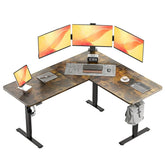Move Better, Create Better: The Graphic Designer's Guide to a Standing Desk
As a graphic designer, your work demands intense focus and long hours spent in front of a screen. While this dedication is great for your craft, it can lead to physical discomfort and creative fatigue. A standing desk offers a simple but powerful solution by adding movement and improving your workspace ergonomics. This guide will help you understand why designers are adopting this change, without any sales pressure—just clear information to help you decide if it's the right move for your studio.
The Physical Toll of Design Work
Hours of sitting can cause a variety of problems that affect both your body and your work:
-
Strain: Leaning in to focus on details can lead to tension in your neck, shoulders, and back. Repetitive mouse or tablet use can strain your wrists and forearms.
-
Fatigue: Prolonged sitting can zap your energy, making it harder to stay sharp for important design decisions.
A standing desk directly addresses the root cause of these issues: a lack of movement. It allows you to change your position, take micro-breaks, and step back to view your work from a fresh perspective.
The Right Way to Use a Standing Desk
A standing desk isn't meant for standing all day. The real benefit comes from regularly switching between sitting and standing. This simple habit keeps your circulation flowing and prevents the stiffness that can build up during long sessions.
-
Switch often: Use an electric or manual desk to change positions every 30–60 minutes.
-
Take breaks: Use these transitions as a cue to stretch or walk around briefly.
-
Keep it fluid: The goal is to make movement a natural part of your workflow, not an interruption.
How a Standing Desk Boosts Your Creativity
Design is both technical and creative, and a dynamic setup can improve both aspects.
-
Clearer Vision: Standing back from your monitor is like a built-in "gallery view," helping you spot layout or balance issues you might miss up close.
-
Sustained Energy: Gentle movement helps stabilize your energy, keeping your brain sharp for tasks like color correction and type pairing.
-
Better Communication: Standing can boost your confidence during meetings or when you’re reviewing work, whether alone or with others.
-
Smoother Workflow: Alternating positions can break up monotony, making it easier to transition between different creative tasks without feeling a mid-day slump.
Many designers use standing as a signal for specific tasks: stand to brainstorm or review, and sit for detailed refinement.

Ergonomics for the Designer’s Setup
To get the most out of your standing desk, fine-tune your workspace to support precision work:
-
Monitor: Position your screen so the top is at or slightly below eye level. For multi-monitor setups, keep your main screen directly in front of you to avoid neck strain.
-
Tablet/Mouse: Ensure your wrists are in a neutral position when using a tablet or mouse. Consider a wrist rest if needed.
-
Body Position: When standing, your elbows should be at a 90-degree angle with relaxed shoulders. Keep your keyboard and mouse close to avoid reaching.
-
Add-ons: An anti-fatigue mat can reduce foot pressure, and a monitor arm can free up desk space and allow for easy height adjustments.
These small changes lead to big gains in comfort and focus.
A 7-Day Plan to Try Before You Buy
You don’t have to commit to a new desk right away. Try this simple experiment to see the benefits for yourself:
-
Day 1: Notice when you feel stiff or tired.
-
Day 2: Stand for a few minutes while reviewing your work.
-
Day 3: Take a quick stretch break every time you export files.
-
Day 4: Try standing during a client call or meeting.
-
Day 5: Stand for brainstorming sessions, then sit for detailed work.
-
Day 6: Evaluate if you feel more energetic or productive.
-
Day 7: List what features you would want in a standing desk.
This helps you build awareness about your personal needs so you can make a smart decision.
Addressing Common Myths
-
"Standing all day is better." The goal is to move, not to stay in a single position.
-
"I'll lose precision." Use standing for high-level reviews and sitting for fine-tuned details.
-
"It's just a trend." The benefits of reducing static sitting are well-documented. For designers, they translate into unique creative advantages.
A standing desk is a tool, and how you use it is what matters.
The Ultimate Payoff
Your workspace directly influences your work. A standing desk is not just a piece of furniture—it’s an investment in your well-being that leads to clearer thinking, less discomfort, and more consistent creative output. Start with small changes and see how they can transform your studio.
To explore ergonomic solutions and find inspiration, you can visit https://vvenace.com/.



